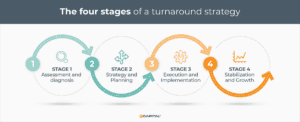
Righting the Ship – The Four Phases of a Financial Turnaround Strategy
Content
- The importance of financial turnaround strategies
- What are the four stages of a turnaround strategy?
- Stage 1: Assessment and Diagnosis
- Stage 2: Strategy and Planning
- Stage 3: Execution and Implementation
- Stage 4: Stabilization and Growth
- How to transition to a more flexible financial structure?
- Conclusion
- Key Takeaways
When a business slides towards insolvency, anxiety and panic can overwhelm business leaders and hinder their ability to correct the situation. However, a commitment to develop effective turnaround strategies and a decisive action plan can pivot the business and rebuild financial health if cooler heads prevail.
Businesses typically follow a defined life cycle from start-up to growth and maturity, then renewal or decline. This path is not always linear, and sometimes it can include a stormy ride of profitability, dipping into poor performance and back again as waves of market conditions change. Experienced business owners learn to ride the worst of these storms without crashing. They accomplish this by following proven turnaround strategies that have passed the test of time.
If stormy conditions endanger your company, learn how to right the ship by following the four phases of a financial turnaround strategy.
The importance of financial turnaround strategies
In most cases, the first thing many business owners do when their business slides toward insolvency is to cut costs. But this tactic will only slow the inevitable if not backed up with coordinated corrective actions. Ultimately, you breathe new life into your struggling business by implementing a focused financial recovery plan.
Turnaround strategies include a range of measures companies employ to recover from a period of performance decline. The period of decline and recovery in performance is called the turnaround and is measured based on net income.
A turnaround strategy can be organized into four stages to reorganize and revitalize a struggling business. If planned and implemented well, a turnaround strategy can help companies facing pressing challenges, reinvent themselves, and stay relevant regardless of market conditions.
What are the four stages of a turnaround strategy?
The core objective of a turnaround strategy is to stop a business’s downward spiral and restore financial health. This process can be organized into the following four stages:
Stage 1: Assessment and Diagnosis
The sooner you react to diminishing financial performance metrics, the better! Regularly review monthly financial statements and reports, plus monitor financial ratio trends to determine the trajectory of your business. Be objective in your assessment: if the business’s financial metrics are slipping into dangerous territory, take immediate action. Conduct internal audits to assess operational efficiencies, identify underlying issues and expose root causes. Examine all aspects of the business and crunch the numbers to determine if your business model is still viable and if so, commit to developing and implementing an effective turnaround strategy.
Stage 2: Strategy and Planning
Next, develop your business turnaround action plan. The plan aims to implement strategies designed to reorganize and revitalize the organization and restore the business to financial health. It details changes to how you conduct your core business, identifies new sales initiatives, outlines staff reductions, and records cost-saving actions. It should include a cash budget and a set of monthly financial projections with objectives indicating how you intend to get out of your situation in measurable terms.
The following are main elements of a turnaround strategy:
Crisis Stabilization: The first objective in an effective turnaround strategy is to conserve cash in the short term and rebuild stakeholder confidence by demonstrating that senior management has taken control of the situation. Restructure finances by decreasing costs and short-term expenditures to relieve financial stress and keep up with payment obligations. Start aggressive cash management to reintroduce predictability into business operations.
Improved Leadership: Typically, the first stages of an effective turnaround plan focuses on your organization’s top management level. Reorganize the management team to overcome dangerous gaps in senior management’s experience and skills.
Strategic Direction: Redefine the core activities of your business, divestment, M&A, and restructuring to better align with current market conditions.
Organizational change: As your turnaround strategies develop, begin focusing on lower level organizational efficiencies. Identify required changes to improve operations, boost employees’ morale, strengthen communications, etc.
Streamline Processes: Adjust the company’s operational, administrative, and financial work practices to address the main risks and barriers to profitability.
Restructuring Finances: Key objectives in turnaround strategies are to improve cash monitoring, tighten controls, enhance equity value, secure short-term funding, sell underutilized assets, and generate improved cash flow.
Your turnaround strategy and resulting action plan serves as a roadmap to save your business. It also convinces stakeholders that the business remains viable and can return to profitability.
All the information you need to develop an effective turnaround strategy can be found in your financial documents. These will give you financial insights and foresight to make the right daily decisions. But be cautious – knowing how to interpret and analyze lag measures to project the results of operational changes is a task best left to skilled business advisers. Consult with experienced turnaround consultants to build a viable turnaround strategy and action plan that’s most likely to succeed.
Stage 3: Execution and Implementation
The next step is to get everybody on board – an “all hands-on deck” mentality ensures maximum team buy-in. Communicating the turnaround strategy to all stakeholders, including employees, customers, suppliers, and investors helps build support and commitment to the action plan.
Monitor progress regularly and adjust turnaround strategies as needed to stay on track and ensure the action plan achieves its goals. This may require ongoing market analysis, regular competitive research, and continuous internal business operations monitoring.
Stage 4: Stabilization and Growth
The end goal of any turnaround strategy is to stabilize operations while preserving the value of the business and protecting stakeholders. Now is the time to institutionalize changes in corporate culture to emphasize profitability, ROI, and return on assets employed. Build continuous management and employee training and development programs to raise the caliber of your human capital.
Most importantly, seek opportunities for profitable growth. Build on competitive strengths and formalize a flexible financial structure that supports investments in efficiencies and business expansion.
How to transition to a more flexible financial structure?
Conventional business financing, such as a bank loan or operating line of credit, is typically difficult for struggling SMBs to qualify for and can take months to arrange. Businesses that utilize conventional financing options are subject to heavy lender oversight and debt covenants that often restrict the company’s ability to stretch finances to support turnaround strategies. Traditional financing options often limit, rather than fuel, business recovery.
However, creative non-bank finance companies take an entirely different approach to business financing by offering flexible funding solutions that are easier and quicker to acquire. Qualification requirements are based on the quality of assets the business possesses. Suppose the company has accounts receivable from creditworthy customers, or equity in inventory, machinery, or equipment. In that case, it is well-positioned to obtain invoice factoring, asset-based lending, or a number of other financing solutions.
Leading non-bank lenders provide cash flow and working capital solutions with minimal lender oversight and few covenants to provide greater financial flexibility. Borrowers can leverage asset strengths to maximize credit and gain access to more capital in more ways than conventional lenders are willing to provide. In addition, the best non-bank lenders allow for credit limits to expand to better support your turnaround strategy and recovery efforts.
Industry leading non-bank lenders are experienced in dealing with businesses in distress and working with banks, and other conventional lenders, to facilitate a smooth and seamless transition of accounts. If your business needs flexible business financing options to support a turnaround strategy, research leading non-bank lenders with experience in your industry. These lenders will help to ensure a smooth transition to a flexible financial structure without funding gaps.
Conclusion
A turnaround strategy is designed to take a struggling business from distress to financial stability.
An effective turnaround strategy and supporting action plan should be in place and initiated within one to two quarters. Behavior and operating change should be evident to employees, customers, and shareholders within two to three quarters, improving morale and confidence. Within three to four quarters, operating fundamentals should show marked improvement. Results are measured in net income or net profit. 20% is considered good, 10% average or standard, and 5% is considered low or poor.
The success of a turnaround strategy is dependent on the company’s ability to assess, reorganize, and revitalize operations to adjust to changing market conditions. Flexible business financing options are also a key to successful restructuring. Seek the help of turnaround advisors and experienced non-bank lenders to ensure the greatest level of success.
Key Takeaways
- A commitment to develop effective turnaround strategies and a decisive action plan can pivot a struggling business and rebuild financial health.
- Turnaround strategies can be organized into four stages and include a range of measures companies employ to recover from a period of performance decline.
- Formalize a flexible financial structure that supports investments in efficiencies and business expansion.
- The success of a turnaround strategy is dependent on the company’s ability to assess, reorganize, and revitalize operations to adjust to changing market conditions.
ABOUT eCapital
At eCapital, we accelerate business growth by delivering fast, flexible access to capital through cutting-edge technology and deep industry insight.
Across North America and the U.K., we’ve redefined how small and medium-sized businesses access funding—eliminating friction, speeding approvals, and empowering clients with access to the capital they need to move forward. With the capacity to fund facilities from $5 million to $250 million, we support a wide range of business needs at every stage.
With a powerful blend of innovation, scalability, and personalized service, we’re not just a funding provider, we’re a strategic partner built for what’s next.



